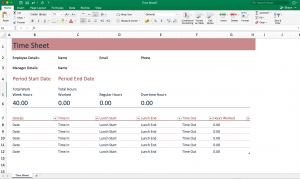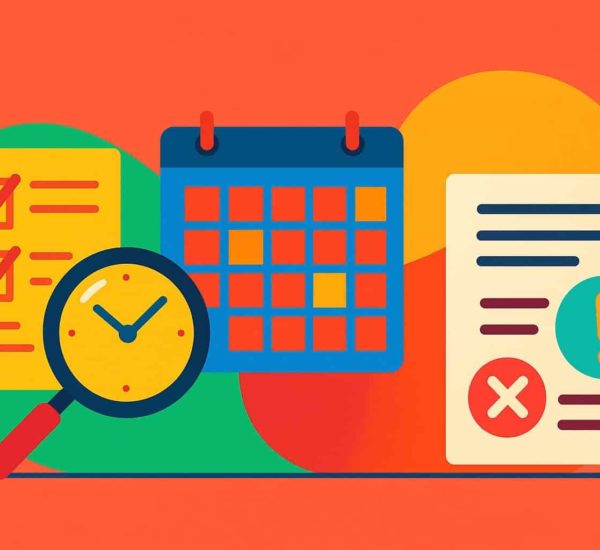What is time tracking?
Time tracking refers to the process of recording, measuring, and documenting the number of work hours for an employee. It helps ensure that the employees get compensated for their time. Time tracking helps increase organisational productivity by identifying the processes that waste work time.
History of time tracking
Humans seek efficiency. Time tracking is a means to measure the efficiency of a business. Due to the advent of continuous technological advancement in the field of time tracking, it may appear to be a new age concept. It is a very old concept and dates back to at least 4000 B.C. when Sumerians invented cuneiform writing as a better system for record-keeping.
A few hundred years later, around 3500 B.C., the Egyptians started measuring time by dividing their day in two parts (day and night) based on the length of the shadow of tall pillars (obelisks). Over 200 years later, they went on to improve this process and invented sundials.
Around 1750 B.C., the Code of Hammurabi mandated fixed pay for a distinct type of work. Edicts in the Code specified occupations and the wages the workers would get by the day. A daily worker’s wage was set at 6 grains of silver (that’s $0.25 / day, without adjusting for inflation). The modern-day Davis-Bacon Wages Act of 1931 resembles the Code of Hammurabi.
With developments in time-tracking technology, the hourly wages replaced the daily wages. In the late 18th century, businesses started using the time clock to track employee attendance, work hours, and to manage payroll.
Around 1950s, service companies introduced the concept of billable hours. Billable hours refer to the number of an employee’s work hours an agency charges to a client. The idea behind billable hours is that the client gets charged only for the number of hours an employee worked on the project. The concept of billable hours made the phrase “Time is money”, a reality.
Time tracking methods
Based on their use cases, businesses use several methods of time tracking:
The Paper Method
As the name suggests, the paper method requires only a pen, paper, and a time measuring device (clock, wrist-watch, or phones). One can note the time before and after working on a task or project on the piece of paper. The advantages and disadvantages of the paper method of time tracking are as follows:
Advantages: It is one of the cheapest methods of time tracking. It is easy to use anywhere.
Disadvantages: This method is useful only when you don’t have to share the timesheet reports in person. In case one has to send the timesheet report one will have to scan the paper document and or click a picture of the paper. This makes the paper method of time tracking time-consuming one.
Despite the drawbacks mentioned above, a lot of businesses still use the pen and paper method for time tracking and payroll.
The Spreadsheet Method
With the arrival of Microsoft Excel and similar spreadsheet software, a lot of businesses started using spreadsheet templates for time tracking. A typical Excel time tracking template comprises 5 columns namely, Date, Activity, Start time, End Time, Hours worked, and Hourly rate. Some businesses also add the ‘Client Name’ column in the timesheet spreadsheet template.

A simple spreadsheet template for time tracking
The advantages and disadvantages of the spreadsheet method of time tracking are:
Advantages: It is very easy to enter timesheet records and takes less time.
Disadvantages: The data still needs to be entered manually and has a scope of error. Adding time manually in itself is a time-suck.
The Honour System
The honour system of time tracking works on the simple principle of trust. The employer trusts the employees’ estimate of the number of hours they put in at a particular task or project and accordingly prepares the timesheet to estimate the cost of the project based on the hourly rates.
The advantages and disadvantages of the honour system of time tracking are as follows:
Advantages: The honour system is the easiest method of time tracking. It does not need any efforts from the employer and the employees.
Disadvantages: Erroneous estimation is possible. An employee can overestimate or underestimate the amount of time he/she would spend on a task which may lead to inaccurate compensation.
An employer using the honour system of time tracking cannot share the details of the amount of time spent on a sub-task when asked by a client.
Time Tracking Software
A time tracking software is the most advanced and modern method of time tracking. It involves using software to track employees’ time hours.
Using a time tracking software is the most accurate method of employee time tracking. It helps measure time spent on a particular task down to a second.
AttendanceBot is the best time tracking software for small and growing companies. It helps employers get detailed, accurate timesheet reports of all employees. AttendanceBot works right inside your instant chat messenger app (Slack, Microsoft Teams, and Google Hangouts Chat).
The advantages and disadvantages of using software for time tracking are as follows:
Advantages: A time tracking software offers the most accurate reporting of employees’ time. This helps with accurate payroll and client billing.
Disadvantages: There is no drawback to using a time tracking software unless it results in intrusion of an employee’s privacy.
Freelancers and part-time employees use timesheet calculator online to create their timesheet reports and share it with their clients or employers for billing. AttendanceBot offers a free timesheet calculator with lunch and breaks time for freelancers.
Types of time tracking software
Standalone
This is the simplest time tracking software and comprises an employee timesheet. Employees and HR can measure time spent on various tasks in real-time using this type of software.
AttendanceBot is a standalone time tracking software that has many other features like absence management, leave management, shift planning, employee onboarding, etc.
Part of a project management software
Project management software that also has a time tracking feature falls into this category. Time tracking in such software is mainly done from a project management point of view. Other features of this type of time tracking software include:
a. time spent on a particular task
b. planning and scheduling projects
c. file-sharing
d. to-do list
e. setting deadline and budget to the project
Part of a billing/invoicing software
Some time tracking software comes a part of the billing or invoicing software that a business uses. The major advantage of this type of time tracking software is accurate client billing.
This type of software helps in generating client invoices based on the total time spent on tasks and hence helps in understanding the earnings and profit per client.
Automatic time tracking software
Time tracking software that automatically track the amount of time spent on various tasks based on the device usage falls into this category.
An automatic time tracking software measures and stores the following details:
a. device (PC, laptop, mobile phone) usage
b. time spent on each application on a device
c. time spent on each website in a browser
d. time spent on and off the keyboard
Some automatic time tracking software also capture and store employee’s device screen, mouse movement, keyboard strokes, etc.
How to make buying decisions for a time tracking software
Every minute counts in a fast-growing company. A productive, effective, and efficient company knows how to track, monitor, and manage time well. This makes choosing the right time tracking software one of the most vital decisions for any business. Here are the most important things you need to consider before making your choice:
Time tracking and reporting features
Time tracking needs differ with the stage of a business. An early-stage small business has different time tracking requirements as compared to medium or large-sized business.
Small business (0-100 employees)
Smaller business employees have to do almost all the tasks that a larger business’ employees perform. However, there are fewer of them to perform the same number of tasks.
Team collaboration is the biggest problem for small businesses. The team has is required to work closely on several varied tasks and projects.
The time tracking software that a small business chooses should have team collaboration and people management at its core. Managers should be able to delegate tasks and each employee should be aware of all the assignments he/she is assigned.
AttendanceBot is the best time tracking software for small businesses. It works right inside the team collaboration and instant messaging software (Slack, Microsoft Teams, and Hangouts Chat).
Medium-size businesses (101-500 employees)
Medium-size businesses generally have more budget as compared to a small business. While the budget is higher, it is always recommended to get an exhaustive software with low pricing.
More employees correspond to a lack of time to explain the software to each employee individually.
Business metrics become more important to these businesses, so the time tracking software should have detailed reporting and analytics. Custom reports should be easily available for HR and managers.
Large companies (500+ employees)
The most important features for a large company include customizations, strong security, integrations, and API access.
Since there are multiple large teams in an enterprise, the time tracking software should have simple people management features as well.
The table below shows how a company should choose the best time tracking software basis its size:
![]()
Team management capabilities
Most businesses today have multiple types of employees, viz, full time, part-time, freelancers, etc. Some employees work from far off locations and are called as remote employees.
While choosing a time tracking software one should keep in mind the type of employees that are going to use the software. For example, using a biometric-based time tracking software is not a good idea for time tracking of remote teams or freelancers.
In the case of freelancers, it’s always advised to make work transparent and accessible. The client should have all the details about the progress of a project and the billable hours.
Freelancers should use a time tracking software that allows them to mention every minute detail about the time spent and also export all the reports to share with the client.
Remote teams and employees need to account for the time to their employer. Unlike freelancers, remote employees have to often collaborate with other employees and teams and therefore, should choose a time tracking software that works right inside their team collaboration or instant messenger software.
Pricing
Every business has a budget to choose software. The time tracking software that one chooses depends on the budget. There are multiple ways time tracking software are priced. Some software set a flat monthly or yearly rate, others set the price based on the number of users(employees in this case), and some offer custom-pricing based on a business’ requirements. Most businesses purchase time tracking software based on the pricing vs features RoI.
Training resources and customer support
The best time tracking software should have all the training resources, FAQs, user manuals, videos, and other training resources in place to make it easy for the end-user to find the solutions to his/her problems.
Most software companies provide 24×5 customer support. Some companies, like AttendanceBot, provide 24×7 customer support to ensure a better user experience.
Available platforms
The time tracking software you choose should work on the platform your team uses. Sometimes, time tracking software may be built only for Windows users or it could be designed as a Mac OS-only product. In most cases, one-time tracking software supports multiple platforms. They support anyone or any combination of the following platforms:
- Collaboration software
- Slack
- Microsoft Teams
- Google Hangouts Chat
- Web application
- Browser extension
- Operating System
- Mac
- iOS
- Android
- Windows
- Linux
A new type of time tracking software has come into existence. They work right inside your team collaboration and instant messaging software like Slack, Microsoft Teams, and Hangouts Chat. AttendanceBot is one such time tracking software.
One should consider what type of device one uses the most, and make ones pick accordingly.
Integrations
The best time tracking software are the ones that help reduce manual work. Integration between 2 or more software further results in increased efficiency.
For example, AttendanceBot seamlessly integrates with your accounting and payroll software making it easier for you to disburse employee salaries, client payments, and measure profits.
A typical time tracking software integrates with the following types of software:
- Project management software
- CRM software
- Invoicing and accounting software
- Payroll software
- Task management software
Ease of use
A time tracking software that is not well adopted by your employees does not yield any value for your business. Simplicity and ease of use are the most important reasons employees will quickly start using time tracking software. The main reason a business buys a time tracking software is to keep a tab on the time spent and improve efficiency. A time tracking software should not consume employee time to make that happen.
Pricing of time tracking software
The typical time tracking software costs between $3 to $20 per user per month. The prices go down by over 25% on an annual subscription.
AttendanceBot plans start from $2 per user per month for the “Good” plan and go up to $6 per user per month for the “Best” plan. Check detailed AttenanceBot pricing here.


